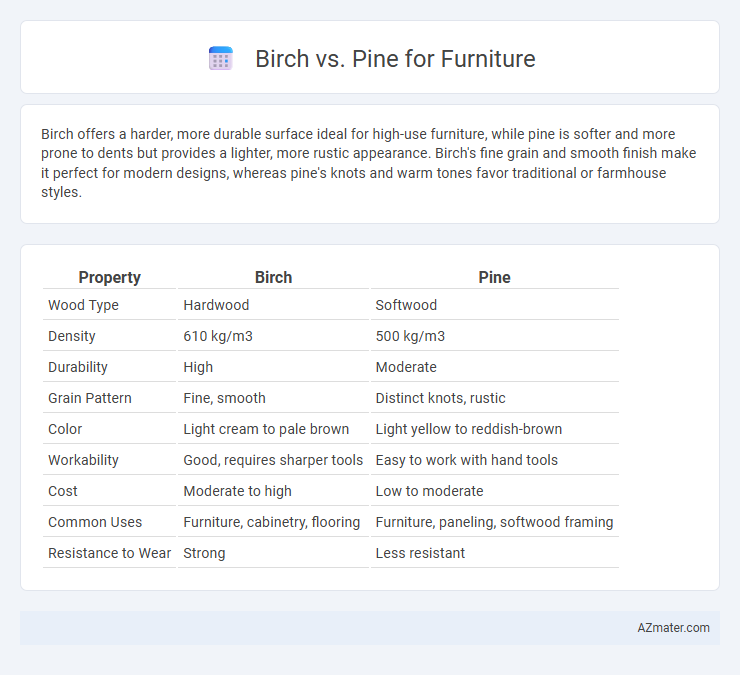Birch offers a harder, more durable surface ideal for high-use furniture, while pine is softer and more prone to dents but provides a lighter, more rustic appearance. Birch's fine grain and smooth finish make it perfect for modern designs, whereas pine's knots and warm tones favor traditional or farmhouse styles.
Table of Comparison
| Property | Birch | Pine |
|---|---|---|
| Wood Type | Hardwood | Softwood |
| Density | 610 kg/m3 | 500 kg/m3 |
| Durability | High | Moderate |
| Grain Pattern | Fine, smooth | Distinct knots, rustic |
| Color | Light cream to pale brown | Light yellow to reddish-brown |
| Workability | Good, requires sharper tools | Easy to work with hand tools |
| Cost | Moderate to high | Low to moderate |
| Common Uses | Furniture, cabinetry, flooring | Furniture, paneling, softwood framing |
| Resistance to Wear | Strong | Less resistant |
Introduction to Birch and Pine Furniture
Birch and pine are popular hardwood and softwood choices in furniture making, each offering unique characteristics. Birch wood is known for its smooth grain, durability, and pale color, making it ideal for modern and sleek furniture designs. Pine furniture, on the other hand, features a distinctive knotty texture, warmth, and affordability, often favored for rustic and casual interior styles.
Birch Wood: Key Characteristics
Birch wood is prized for its fine, consistent grain and light color, which make it ideal for smooth finishes and contemporary furniture designs. Its density and strength provide durability, while its resistance to warping ensures stability over time in furniture construction. Birch also takes stains and paints well, allowing for versatile aesthetic options in cabinetry, tables, and chairs.
Pine Wood: Key Characteristics
Pine wood is a softwood known for its light color, straight grain, and smooth texture, making it a popular choice for furniture that requires easy workability and a natural rustic appearance. It is relatively lightweight and moderately durable, with good resistance to shrinking and swelling, but is softer than birch, making it more prone to dents and scratches. Pine furniture often features knots and natural imperfections which enhance its aesthetic appeal in country or cottage-style designs.
Birch vs Pine: Durability Comparison
Birch offers superior durability compared to pine due to its dense grain structure and hardness rating of 1260 on the Janka scale, making it more resistant to dents and wear. Pine, with a lower Janka hardness of 420, tends to be softer and more prone to scratches and dents, making it less ideal for high-traffic furniture. The longevity of birch furniture under frequent use is significantly higher, making it a preferred choice for durable furniture pieces.
Aesthetic Differences: Birch vs Pine
Birch furniture showcases a fine, even grain with a pale, creamy color that offers a modern and sleek aesthetic ideal for contemporary interiors. Pine features a more pronounced grain with knots and a warm, yellowish hue that lends a rustic and cozy charm to furniture pieces. The smoother texture of birch allows for high-quality finishes, while pine's natural imperfections create a distinctive, country-style appearance.
Workability and Crafting Ease
Birch wood offers excellent workability due to its fine, even grain and consistent texture, making it ideal for detailed furniture crafting and smooth finishes. Pine is softer and easier to carve, which simplifies shaping and assembling but may dent or scratch more easily during the crafting process. Both woods suit woodworking projects, but birch is preferred for precision and durability, while pine is favored for quick, lightweight furniture builds.
Cost Analysis: Birch Furniture vs Pine Furniture
Birch furniture typically costs more than pine due to its denser grain and greater durability, making it a preferred choice for high-quality pieces intended to last longer. Pine furniture is generally more affordable, benefiting from the wood's abundance and faster growth rate, which reduces production expenses. Cost considerations also include maintenance; birch requires less frequent repairs or refinishing compared to pine, which may incur higher long-term upkeep costs.
Environmental Impact and Sustainability
Birch wood, sourced from fast-growing hardwood trees, typically offers a more sustainable option for furniture due to its ability to regenerate quickly and its widespread availability in managed forests. Pine, a softwood, grows even faster and often requires less energy-intensive processing, reducing its overall carbon footprint during production. Both birch and pine are biodegradable and recyclable, but sustainably harvested pine forests can offer better carbon sequestration benefits, making pine furniture a slightly greener choice when sourced responsibly.
Best Uses: Choosing Birch or Pine by Furniture Type
Birch is ideal for furniture that requires durability and fine detail, such as cabinets, dressers, and tabletops, due to its hard, dense grain and smooth finish. Pine suits rustic or casual furniture like bookshelves, bed frames, and children's furniture, offering a lightweight, softer texture that is easier to shape and stain. Selecting between birch and pine depends on the desired strength, wear resistance, and aesthetic style for specific furniture pieces.
Birch vs Pine: Which is Better for Your Home?
Birch offers a smooth, fine grain and a light color that enhances modern furniture designs, making it durable and resistant to dents. Pine features a softer texture with a distinct knotty pattern, providing a rustic charm but is more prone to scratches and dents. For longevity and a clean, contemporary look, birch is better suited to high-traffic home furniture, while pine works well for casual or decorative pieces.

Infographic: Birch vs Pine for Furniture
 azmater.com
azmater.com